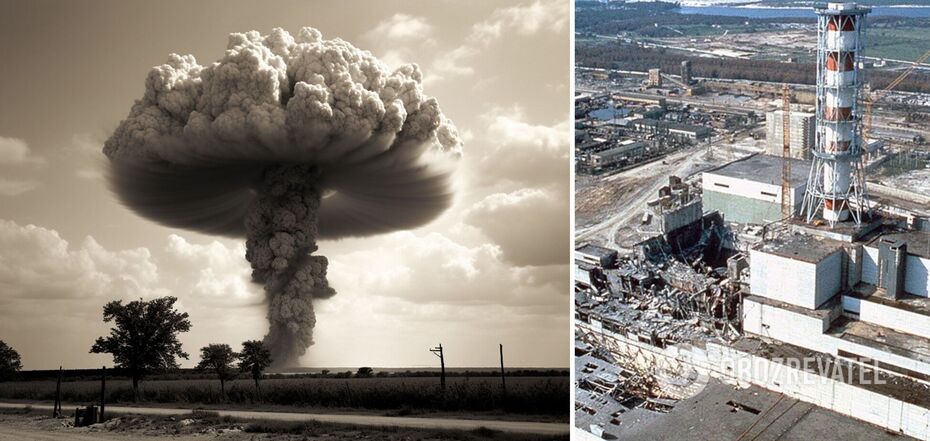Life
Why people can live in Hiroshima and Nagasaki, but not in Chernobyl: it's not just about the explosion
The world is aware of three nuclear disasters that have caused incredible destruction and loss of life. These are the dropping of atomic bombs on Hiroshima and Nagasaki and the accident at the Chernobyl nuclear power plant. Although Chernobyl clearly lags behind the Japanese cities in terms of the scale of destruction, it was part of the Ukrainian territory that became a wasteland, while the Japanese rebuilt their cities.
And it's not a matter of how much time has passed or the industriousness of the Japanese. As IFLScience explains, it's not even so much about the explosion itself as about the aftermath.
"The Kid," "Fat Man," and the Nuclear Reactor
In August 1945, as World War II was drawing to a close, the United States dropped two nuclear bombs three days apart, the "Little Boy" and the "Fat Man," on the Japanese cities of Hiroshima and Nagasaki. The ruthless strike killed between 129,000 and 226,000 people. Most of the victims were civilians. Many of the survivors were diagnosed with a variety of serious illnesses in later years.
This bombing was so horrific that the mere mention of this weapon brings existential dread to anyone.
As a result of the reactor explosion at the Chernobyl nuclear power plant in April 1986, a radioactive cloud covered parts of Ukraine, Belarus, and also Russia. In all, about 60 people are believed to have died as a result of the explosion, as well as for another week. However, given the total secrecy in the USSR and the way the authorities tried to lie about the scale of the tragedy, there could be many more victims.
In all, about 4,000 people died from the consequences of the explosion, but this also includes those who died decades after the accident from radiation-induced illnesses. In all, about 600,000 people were exposed to radioactive radiation.
But despite the power of those explosions, people live in Hiroshima and Nagasaki now. And there is still an exclusion zone around the Chernobyl nuclear power plant, where it is dangerous to stay for long periods of time.
It's all about radiation
To explain briefly, the main reason for this difference is how much radiation was released in the explosions. But the difference between Hiroshima and Nagasaki and Chernobyl is also in the nature of the disasters themselves.
The bombs dropped on Hiroshima and Nagasaki were detonated far above ground level to maximize the explosive power and increase the kill zone. But such an explosion reduced the level of radiation.
In contrast, the explosion at Chernobyl, which was much smaller and occurred at ground level, released 400 times more radioactive material into the atmosphere and also left large pieces of nuclear fuel debris (reactor parts contaminated with radiation) on the ground.
There is also a difference in how much uranium-235 (U-235) isotope was used in the bombs and how much was used in the Chernobyl nuclear power plant.
Most nuclear munitions and reactors use enriched uranium containing a high concentration of U-235. This isotope forms the fuel for the reactors and causes the bomb to explode.
What happens is as follows: neutrons split U-235 atoms, releasing large amounts of energy. The U-235 atom itself, as it splits, also releases neutrons that split even more U-235 atoms, increasing the amount of energy released. And this process continues in a chain reaction.
The main goal of the nuclear weapon is to explode, releasing as much energy as possible: that is, to split as much uranium as quickly as possible. Since the explosion is instantaneous, you don't need that much uranium to be powerful. In particular, the "Little Boy" dropped on Hiroshima contained 64 kilograms of enriched uranium.
However, a nuclear reactor does not require a large amount of energy all at once. There, control rods are used to absorb additional neutrons, allowing the fission chain reaction to be maintained at a lower intensity, but for much longer. This is why the reactor needs significantly more enriched uranium - the Chernobyl nuclear power plant had about 180 tons of fuel.
In addition, the nuclear plant also stores spent radioactive fuel, which contains extremely harmful cesium, iodine and graphite.
So when the explosion occurred at the ChNPP, it was amplified not only by the amount of fuel in the reactor, but also by the spent radioactive fuel. And all of this went up into the sky, subsequently settling in the surrounding area.
These byproducts have a long half-life, which is what makes them so harmful to humans and turns the Chernobyl zone into an inhospitable wasteland.
OBOZREVATEL also reported that dogs in Chernobyl were found to have special genes.
Subscribe to OBOZREVATEL channels on Telegram and Viber to keep up with the latest developments.



























